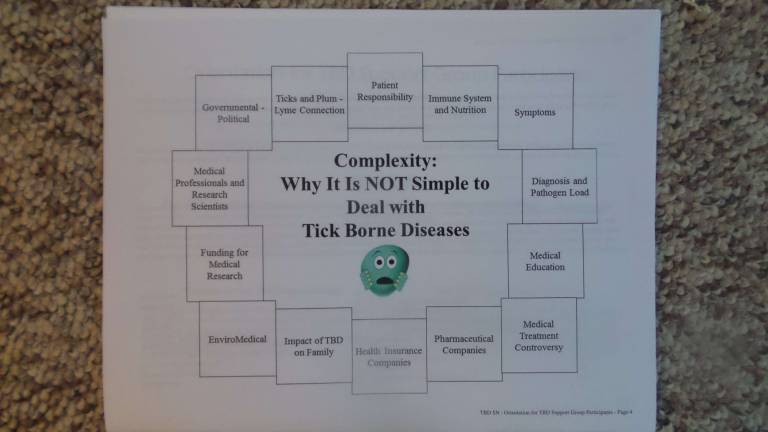State and medical community are behind the times on tick-borne disease, local experts say

By Frances Ruth Harris
MILFORD — In Milford Borough, ticks can carry multiple pathogens. But tick experts Mikki Weiss, lab director Nicole Chinnici, and microbiologist Dr. Robert Ollar say Pennsylvania deliberately refuses to recognize Bartonella as a dangerous tick pathogen. It discourages testing ticks found on humans.
"Sometimes the science is moving faster than the medical community," said Ollar on May 17, when residents came to Milford Borough hall to hear the borough ticks report. "It's sorta like we're working with electric lights and the medical community is still working protecting the kerosene lamps."
The biggest problem is pushback from the medical community, he said. Lyme disease is not a synonym for all tick-borne disease, he said.
Treatment lagsWeiss, CEO and president of the nonprofit TBD network, said the Northeast Wildlife DNA Laboratory in East Stroudsburg tested a tick found on a family member's body and, 22 hours later, and determined it was carrying Bartonella.
Weiss asked the physician to prescribe something for Bartonella because her family member was already showing symptoms. A week passed between the time the family member was bitten to the time she received treatment that ultimately lasted 70 days.
With early diagnosis and treatment — in this case, diagnosis of the tick — people can get the help that is available, she said.
“We are not getting the appropriate diagnosis from the medical profession now, and this is a major concern," Weiss said.
Prompt help isn't happening, she said.
"We're finding three pathogens that are afflicting the residents of Pennsylvania," she said, showing a chart of people who tested positive from 2010 to 2016.
The original strain Borrelia Burgerfi, which is accompanied by a rash, is determined by the C6 peptide test, the definitive test for this organism.
There are other strains and species of Borrelia, and TBD has charts for them too. These can account for a whole range of painful symptoms.
Weiss said that in 2011, she had Borrelia, with a rash that covered part of her body and gave her flu-like symptoms.
Two years later, she said, “I was bitten again, and then all hell broke lose. There was not a part of my body that was not effected by some aspect of the Bartonella group. Batonella is for some reason unknown to most of the medical profession around the country."
She said some members of the medical professional say Bartonella is possibly more of a problem than Lyme disease, but many people are not getting the appropriate diagnosis.
Throughout the commonwealth, she said, there are three tick-borne pathogens: Lyme disease or Borrelia Burgerfi, Babesia, and Bartonella.
All three were found in backlegged ticks collected from Milford Borough during a recent survey. The local bar association provided $2,500 for the study. Many members of the bar association and their families suffer from tick borne diseases, Weiss said.
On May 11, the Pennsylvania Department of Health did an upgrade requiring notification if doctors found tick diseases in their patients, said Weiss — but it still does not recognize Bartonella. If the state is only testing for Lyme, that means seriously ill people are suffering and even dying, she said.
Weiss said ticks must be tested.
Their “arrogance, neglect and a failure to do their fiduciary responsibility in getting the word out is appalling," she said. "They are not willing to do what they are supposed to do. This has to be dealt with, and will.”
One tick, four pathogensChinnici said the survey sampled ticks from several areas in the borough, including Mott Street by the new bridge and at the ball park.
The James Street site tested 60 percent positive for Lyme disease, with 2 percent positive for Babesia micro parasite. The 2 percent were also positive for Lyme disease.
She said 10 percent of the ticks were co-infected with Lyme with Babesia.
“You can't beat Babesia with antibiotics," she said.
One tick that tested positive for four pathogens.
“We're seeing it more commonly, and it's getting scarier how many ticks we are showing co-infections," said Chinnici.
The next step in their research will be to collect 1,000 ticks from ten segments of Pike County, including Milford, and test them for nine pathgens.
Chinnici said within 15 minutes of a tick bite, transmission takes place. Within 24 hours, Lyme disease is transmitted.
Ollar said Bartonella is very smart. It hides out from antibiotics in the linings of blood vessels and goes inside cells, where it is protected.
It's an intracellular pathogen that makes it through antibiotic treatment, he said.
Depending on the pathogen, three to four antibiotics may be required. TBD can also affect unborn children, he said.
He warned that blood transfusions in Pennsylvania should be examined for TBD pathogens, and that the medical community needs to have continuing education as new information becomes available.
“Ignorance does not satisfy a situation of a multiple pathogenic event," he said.
Treating AIDS is easier than TBD because AIDS is predictable, he said. Tick borne diseases present pathogens at their most extreme, he said.
“TBD has its own bag of nasties," said Ollar. Editor's note: This article has been updated to correct the spelling of Dr. Ollar's name. The Courier regrets the error.